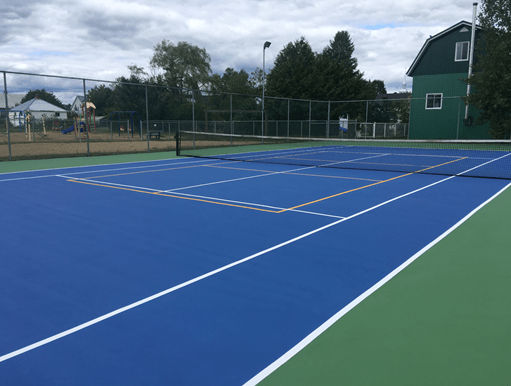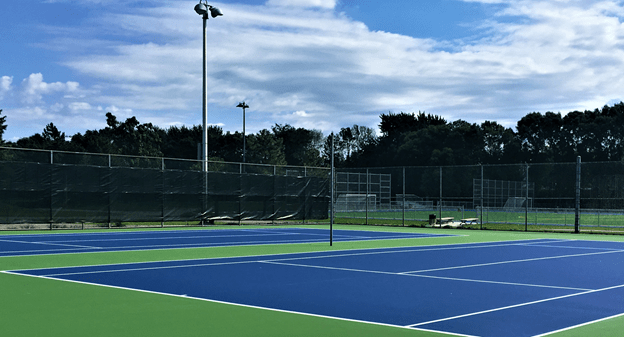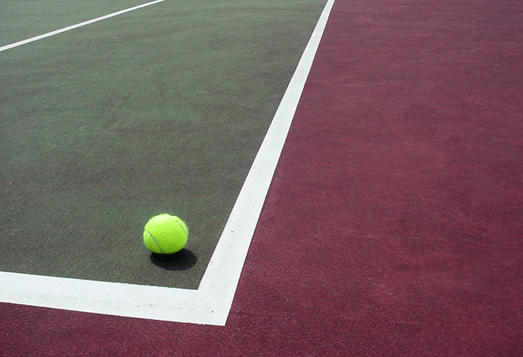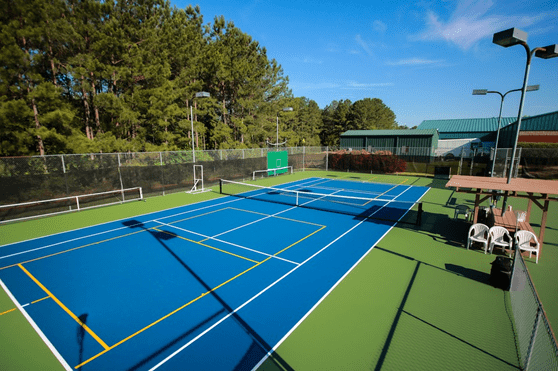Tennis is a sport with multiple types of acceptable playing surfaces. Even at the highest level of international competition, professional tournaments are held on a variety of different surface types.
The U.S. and Australian Opens are played on hard courts, while the French Open at Roland-Garros is played on red clay courts, and Wimbledon, the oldest tennis tournament in the world, is still played on all-grass courts.
Broadly speaking, there are three main types of tennis court surfaces:

Hard courts are made from an asphalt or concrete base and surfaced with acrylic. Concrete and asphalt courts are found everywhere because hard courts that are properly built and maintained are highly resistant to the elements, making them ideal for outdoor courts.
They are also a popular choice for indoor courts because they are cost-effective, highly customizable in terms of colour and surface pace and versatile enough for multi-sport courts.

Clay tennis courts provide a slower surface pace and higher ball bounce than asphalt tennis courts. These soft court surfaces offer some interesting play dynamics, but this tennis surface is not well suited to all climatic conditions, which is why they are more popular in warmer climates. Requiring water, rolling and brushing for optimal play conditions, clay courts cannot be used in freezing conditions.
Whether natural grass or some sort of synthetic turf, grass and artificial grass court surfaces offer the combination of fast play with a soft surface. Loved by tennis players but harder to build and maintain than other surfaces, grass courts require significant maintenance and upkeep to remain playable. Because they have specific climatic, watering and soil conditions, natural grass courts are few and far between.

As tennis players know, the International Tennis Federation (ITF) breaks down tennis court surfaces into five categories, ranging from slow (Category 1) to very fast (Category 5), based on a measurement known as the court pace rating (CPR). Court pace ratings quantify the interaction between a ball and the tennis surface using various metrics, such as post-impact ball velocity and vertical restitution.
With MAPEI’s systems and products for tennis court surfaces, anyone looking to install or repair a tennis or pickleball court surface can achieve the desired playing surface, thanks to products specifically designed and approved to meet the requirements of the ITF:

For durability, playability and versatility, a hard court surface is the best choice for both indoor and outdoor tennis courts.
Whether you are considering a new project or looking for ways to repair and improve existing tennis courts, MAPEI’s single-source sports surface solutions, Mapecoat TNS, are highly specialized products designed specifically for the installation of new or refurbished tennis court surfaces.
Designed for high UV-resistance and low maintenance throughout their lifetime, Mapecoat TNS products have been certified by the International Tennis Federation (ITF), and MAPEI is a member of the American Sports Builders Association (ASBA), Professional Tennis Registry (PTR) and Professional Pickleball Registry (PPR).
Covering the full range of system solutions for tennis courts, as well as skating rinks, and multifunction arenas, Mapecoat TNS products were designed to address the most common issues faced by these installations, such as cracks, potholes and moisture damage.
The Mapecoat TNS line of products includes everything one might need for a new tennis and pickleball court construction. However, this section will assume an existing asphalt or cementitious substrate in order to focus on surface refurbishment.
Refurbishing an existing substrate begins with applying an acrylic base coating to prepare the surface for reinforcement, colours and topcoats.
The preparation is based on what the floor is made of. It could be asphalt, concrete or acrylic hardcourts. Whatever it is, MAPEI can offer specific solutions for your needs.
Once your substrate has been prepared, the remaining steps are to apply a base color before the final, textured finish.
Mapecoat TNS Base Color is a flexible, acrylic base colour coating, available in 29 standard colors as well as virtually unlimited custom colour options thanks to ColorMapTM system technology.
For a premium look and feel, Mapecoat TNS Finish 1 or Mapecoat TNS Binder are easily applied with a soft rubber squeegee, creating a durable finish befitting of a professional tour facility, just as much as recreational surfaces. These easy-to-use products feature superior elongation and flexibility for optimal surface coverage.

MAPEI’s sports flooring solutions are not limited to just tennis courts. Playing surfaces for basketball, cycling and even inline roller skating can be easily refurbished and brought to new levels of performance with the Mapecoat TNS line of products.
Suitable for both temporary and permanent applications, both indoors and outdoors, Mapecoat TNS offers nearly infinite colour customization possibilities while allowing owners to save time and money thanks to long-lasting solutions.